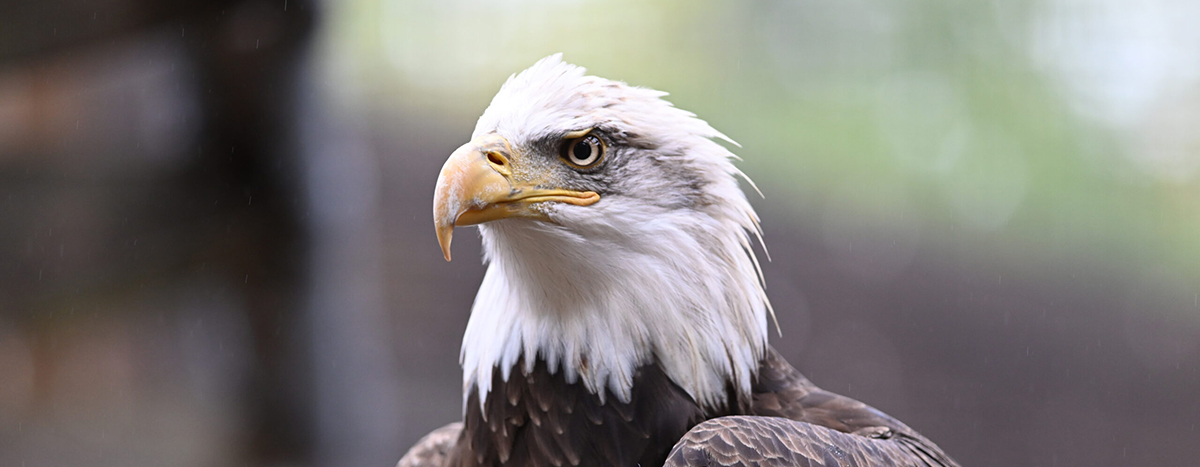
Shaver’s Creek Environmental Center is a beautiful place for anyone interested in the natural world.
Shaver’s Creek Environmental Center is home to a variety of birds, including hawks, owls, eagles, vultures, falcons, and more. All of our resident birds carry out the impactful mission of inspiring conservation for their species and ecosystems.
The public is invited to visit Shaver’s Creek on the weekends from mid-June to November for Meet the Creek, a free public program where an interpreter answers questions and shares information about our resident birds with our visitors.
Accessibility
The Klingsberg Aviary is wheelchair- and stroller-friendly, accessible via a paved ramp. Pathways within the aviary are composed of compact gravel with a slight grade. If you require special parking accommodations, please call Shaver’s Creek at 814-863-2000 for more information when planning your visit.
Our Resident Animals
Sponsor the daily care of our resident animals through our Honorary Animal Caretaker program!
American Crow

Highly adaptable and widespread, crows are some of the most well-known and commonly spotted birds in North America. They socialize in a variety of groups and are highly resourceful. Despite being common, there is still much to be discovered about this brilliant species!
American Kestrel
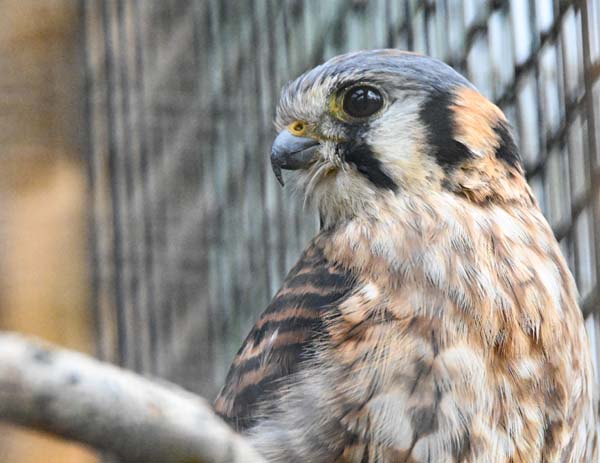
American Kestrels require natural tree cavities, nest boxes, or buildings for breeding. Kestrels are beneficial predators in farmlands, preying on a variety of agricultural pests. Unlike most raptors, American Kestrels differ in appearance between male and female.
Bald Eagle
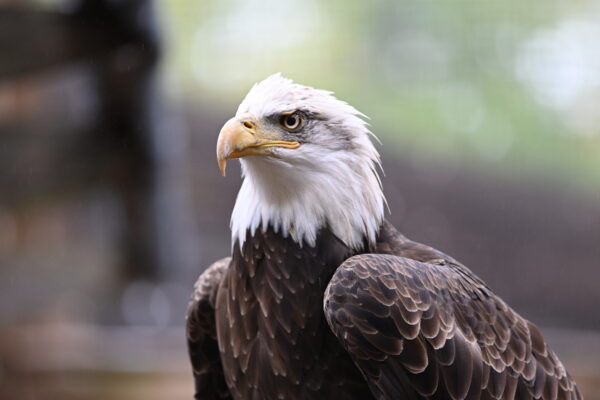
The Bald Eagle was on the brink on extinction in the lower 48 states in the latter half of the twentieth century due to illegal hunting and DDT. However, through diligent effort from government agencies, conservation groups, environmental regulations, as well as the Bald and Golden Eagle Protection Act, our national emblem has made an incredible recovery and was removed from the endangered species list in 2007. In winter, Bald Eagles may congregate in large numbers around bodies of water, preying on fish and waterfowl.
For more, check out the Hanover Bald Eagle Nest camera.
Barred Owls
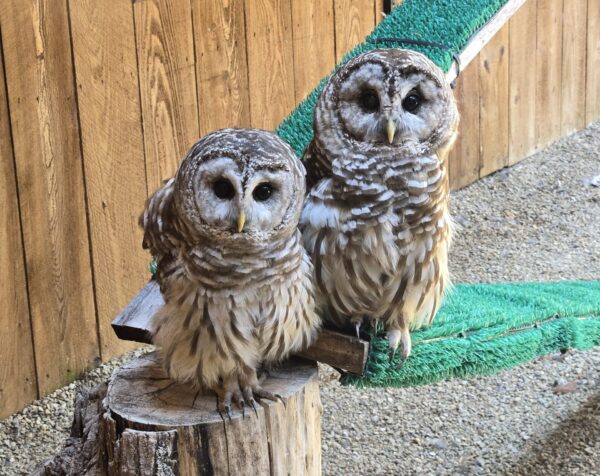
Listen for Barred Owls calling at dusk and dawn with a distinct 8-note “hooting” call (“Who cooks for you? Who cooks for you all?”). Barred owls do best in old growth forest, where they nest in secondary tree cavities.
Black Vulture

Black Vultures are known for their ability to scavenge on carrion, making them essential to maintaining cleanliness and reducing risk of diseases such as rabies and botulism. Matilda, our Black Vulture, demonstrates this by picking through enrichment objects to find morsels.
Broad-winged Hawk

Watch for migrating Broad-Winged Hawks during the months of September and April, forming groups called “kettles” in thermals or slope-soaring along Pennsylvania ridges. This small, stocky species depends on large tracts of forest to breed.
Golden Eagle
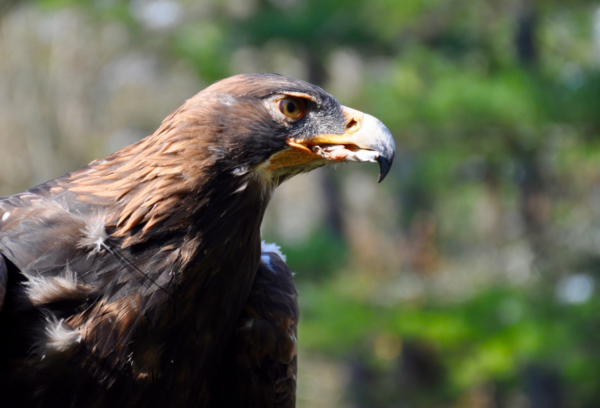
Golden Eagles migrate through central Pennsylvania, but generally when cold, northwesterly winds strike our ridges in late fall and winter. A few winter in rural areas of the state. One of the best place to observe Golden Eagles in the east is just a few miles from Shaver’s Creek on Tussey Mountain.
To learn more about how to observe migrating Golden Eagles, visit our Citizen Science page.
Great Horned Owl

With their tufted, earlike plumicorns, deep hooting call, and striking yellow-eyed gaze, Great Horned Owls have an allure that is favored in storybooks and on screen. This iconic reverence empowers them as a flagship species in conservation efforts for all owls and birds of prey. These charismatic predators are adaptable in both their prey and their habitat. They eat anything from dainty mice and frogs to mammals and birds even larger than themselves and can be found everywhere from the Arctic to the tropics, from farms to cities, and from forests to backyards.
Northern Goshawk

The phantom of the forest, the boreal ghost, the Northern Goshawk. Occasionally heard but rarely seen, these secretive birds prefer to reside in diverse mature forests. Primarily a hunter of birds and small mammals, these birds have become renowned across the globe for their speed and agility, which enables them to be successful chasing their prey among the many branches of their woodland home.
Peregrine Falcon
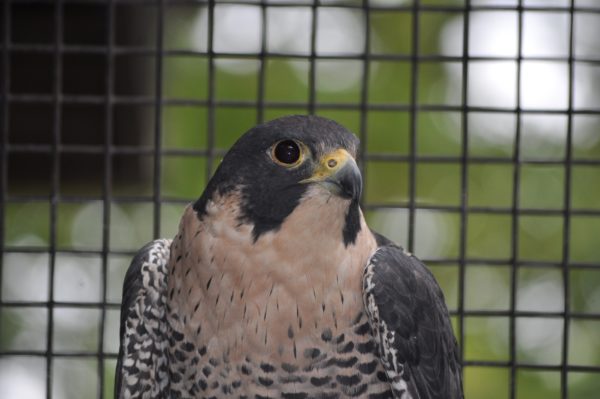
Keep an eye to the sky. Peregrine Falcons are the fastest animals on the planet as they dive at speeds around 200 mph to hunt their avian prey. And along with Bald Eagles, Peregrines are making a steady comeback after the banning of DDT, a harmful pesticide that caused this species to lay too-thin and easily-breakable eggs. Pennsylvania-born scientist Rachel Carson was instrumental in calling attention to the ecological impacts of DDT with her 1962 book, Silent Spring.
Learn more: check out the Peregrine Falcons that nest on the Rachel Carson Building in Harrisburg.
Red-tailed Hawk

One of the most widespread and successful raptors in North America, they have adapted well to human habitats, including highway medians and cities. Soaring hawks like Red-tails are known as Buzzards on other continents. Like all migratory birds in the United States, they are federally protected by the Migratory Bird Treaty Act of 1918. This makes it unlawful to possess, pursue, hunt, take, capture, or sell birds or their parts (including feathers, eggs, and nests).
Rough-legged Hawks

One of the largest hawk species in Pennsylvania, these impressive birds have some of the smallest prey, hunting almost exclusively rodents. The striking and graceful Rough-legged Hawks can often be seen flying low and slow above pastureland and fields, occasionally stopping to effortlessly hover, adding an elegance to the winter landscape.
Sandhill Crane

Amber-colored eyes reveal a bird that has persevered through time. Sandhill Cranes have been navigating the many marshes and grasslands of North America for the last 2.5 million years, making them one of the oldest known bird species. Still a relatively rare sight in Pennsylvania, Sandhill Cranes have been recovering in numbers in recent years and are appearing in more and more places across our state year-round.
Remembering Species We Have Lost
 The Passenger Pigeon sculpture that stands at the entrance to the aviary is part of The Lost Bird Project and is being permanently displayed at Shaver’s Creek thanks to the generosity of Dr. Cyrus Klingsberg. The Lost Bird Project, conceived by artist Todd McGrain, recognizes the tragedy of modern extinction by immortalizing North American birds in sculpture.
The Passenger Pigeon sculpture that stands at the entrance to the aviary is part of The Lost Bird Project and is being permanently displayed at Shaver’s Creek thanks to the generosity of Dr. Cyrus Klingsberg. The Lost Bird Project, conceived by artist Todd McGrain, recognizes the tragedy of modern extinction by immortalizing North American birds in sculpture.
Once considered the most abundant bird on earth, the Passenger Pigeon was a bird of the eastern deciduous forest, where it fed on chestnuts, acorns, beechnuts, and the soft fruits of trees and shrubs. It formed massive flocks that were said to have darkened the sky when they passed, and they nested in colonies of hundreds of thousands of pairs. The clearing of the eastern deciduous forest, as well as market hunting, took the species from billions to none. The last Passenger Pigeon recorded in the wild was shot in Ohio in 1900.
